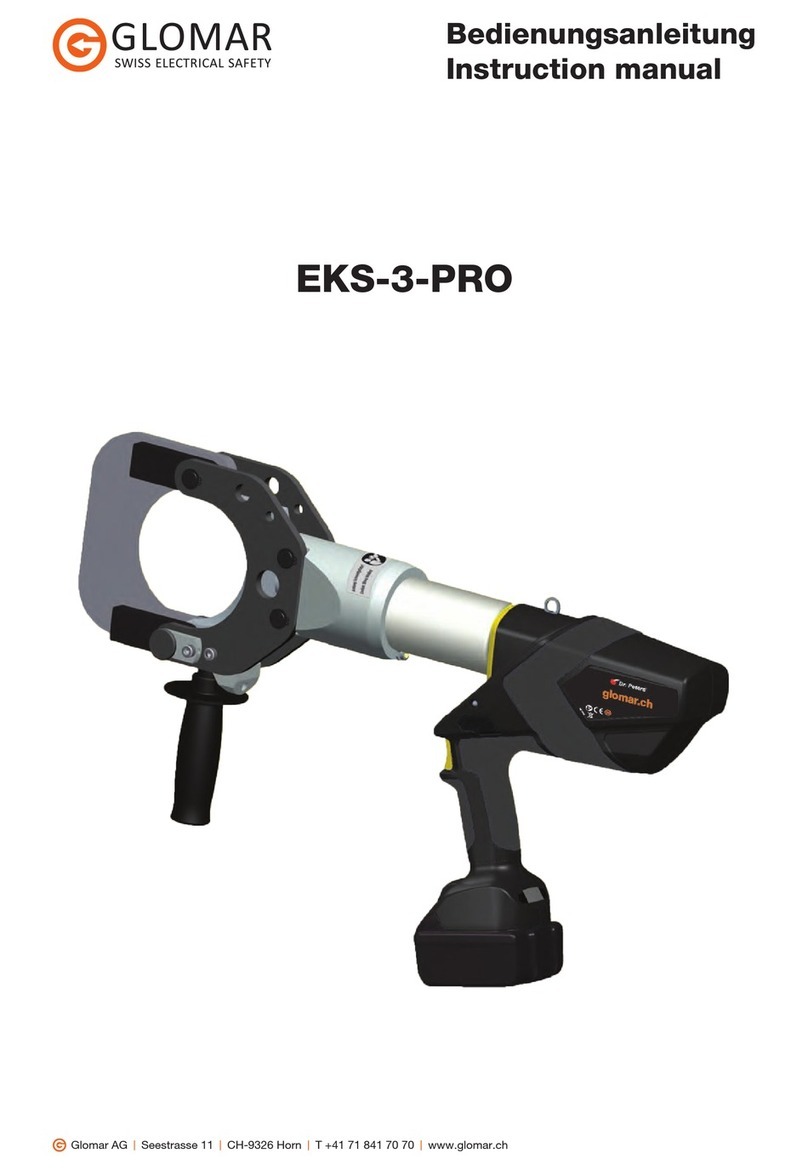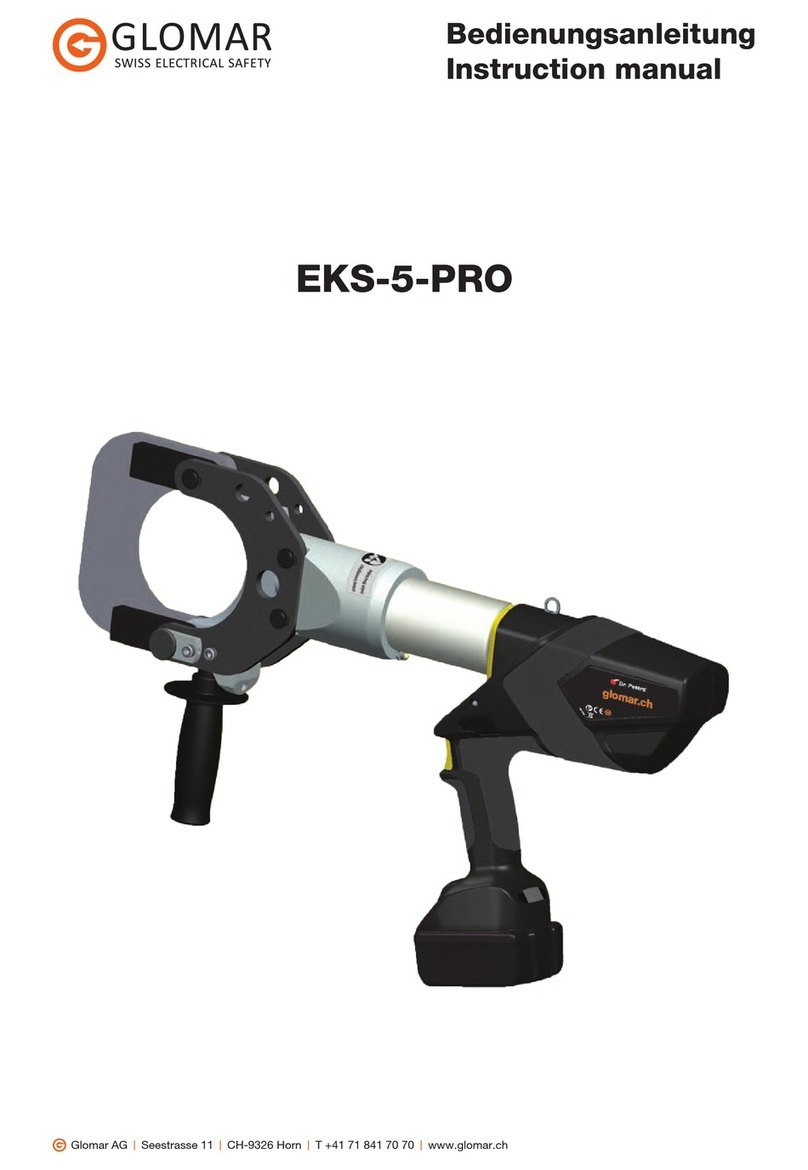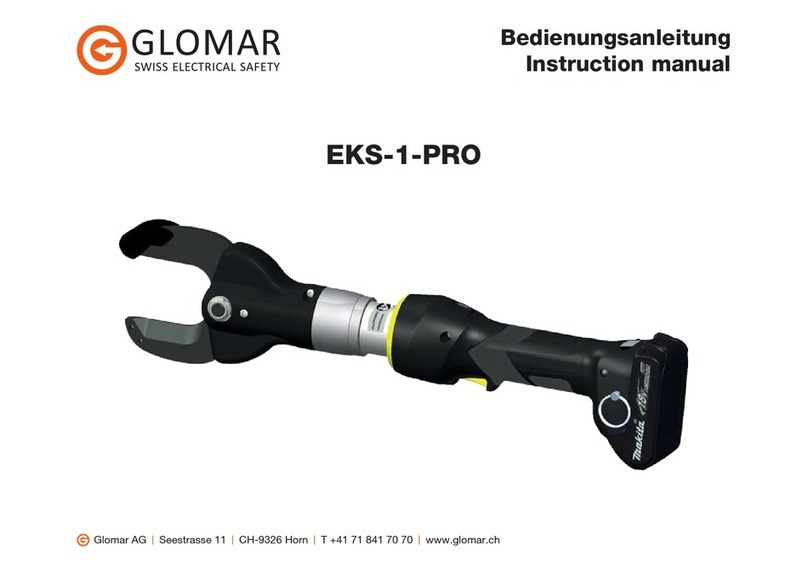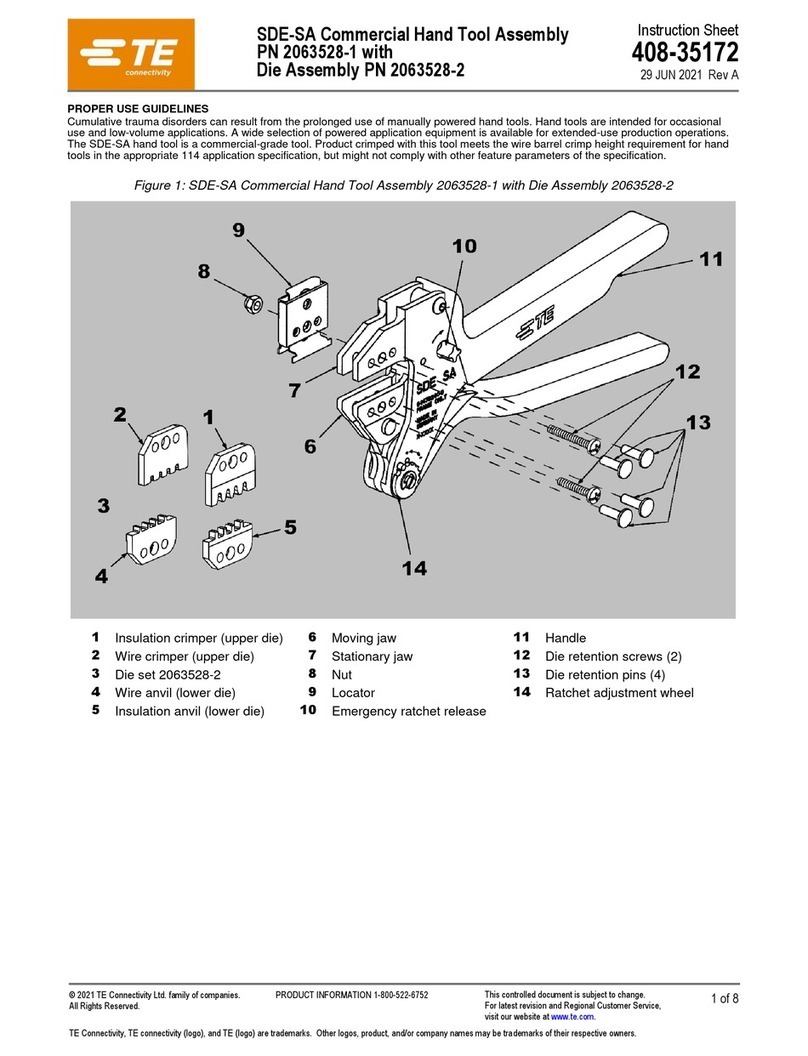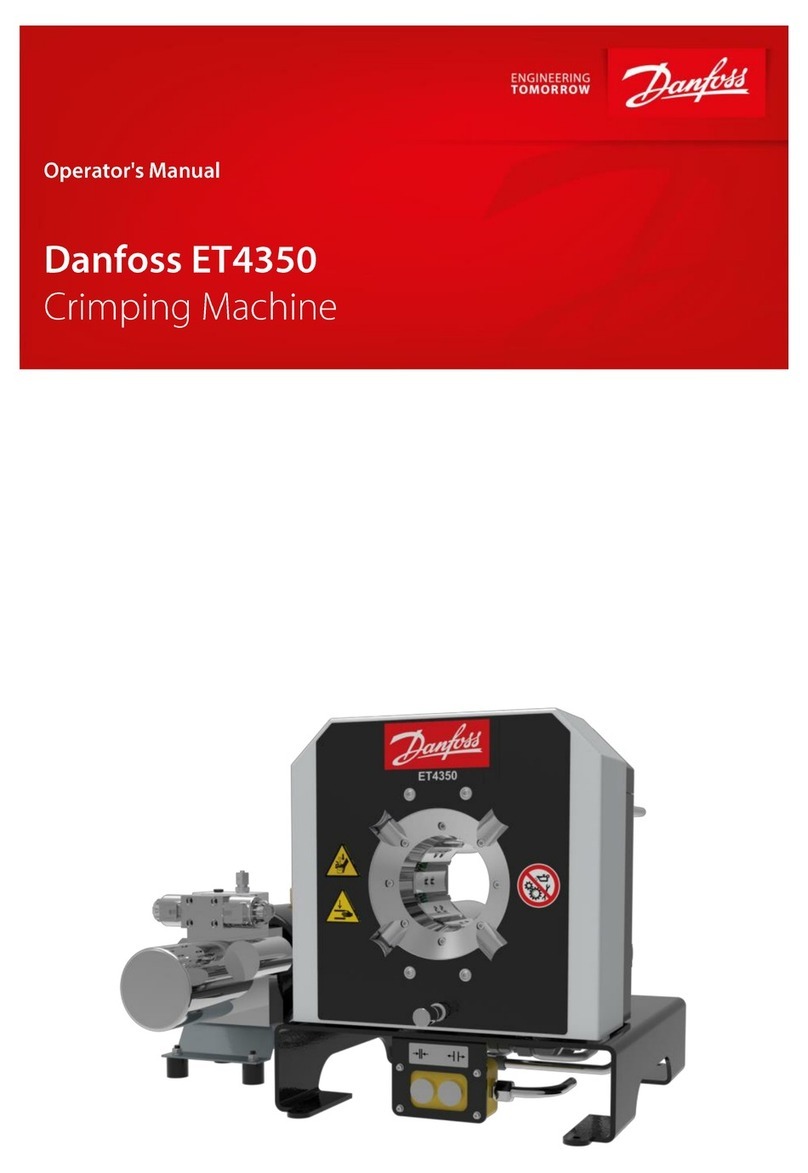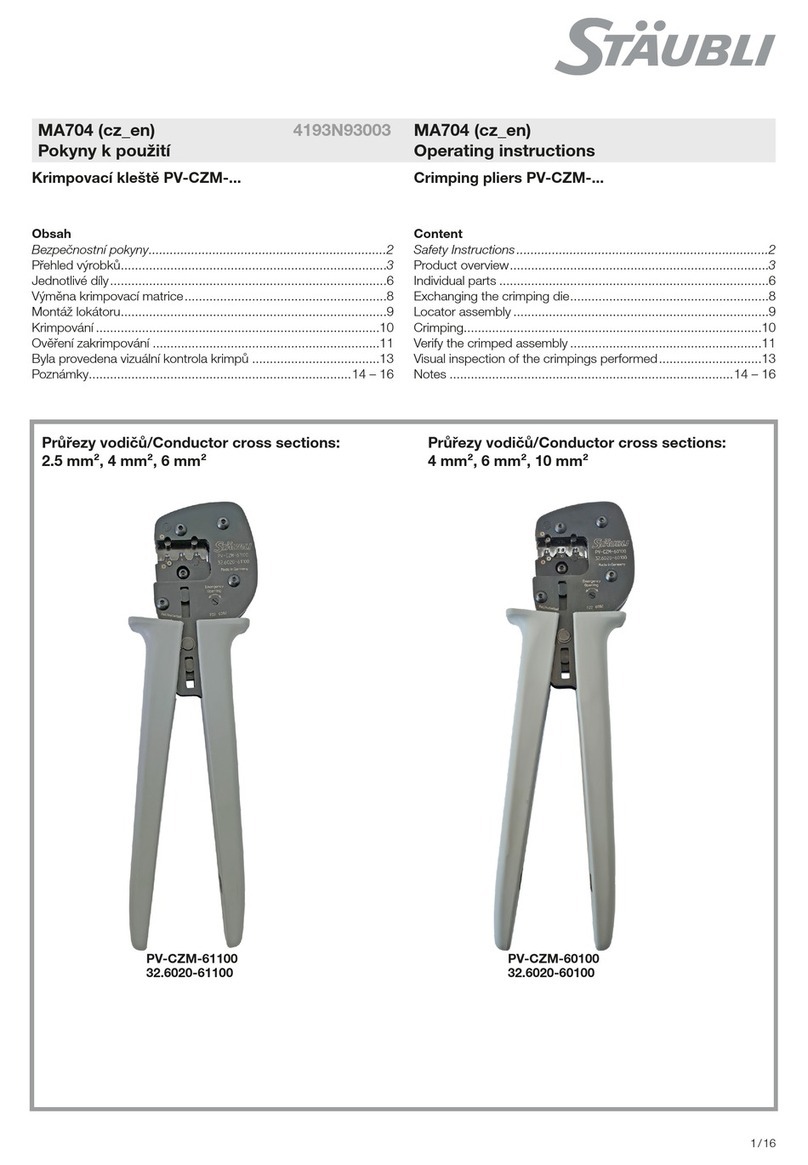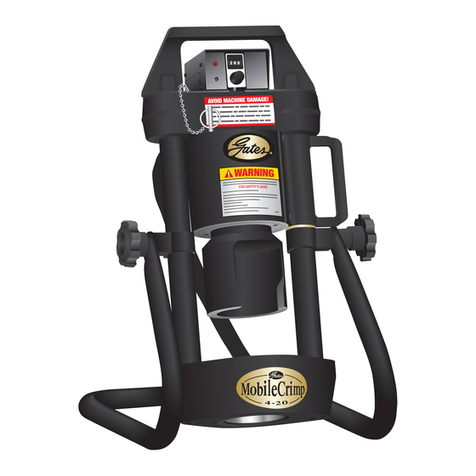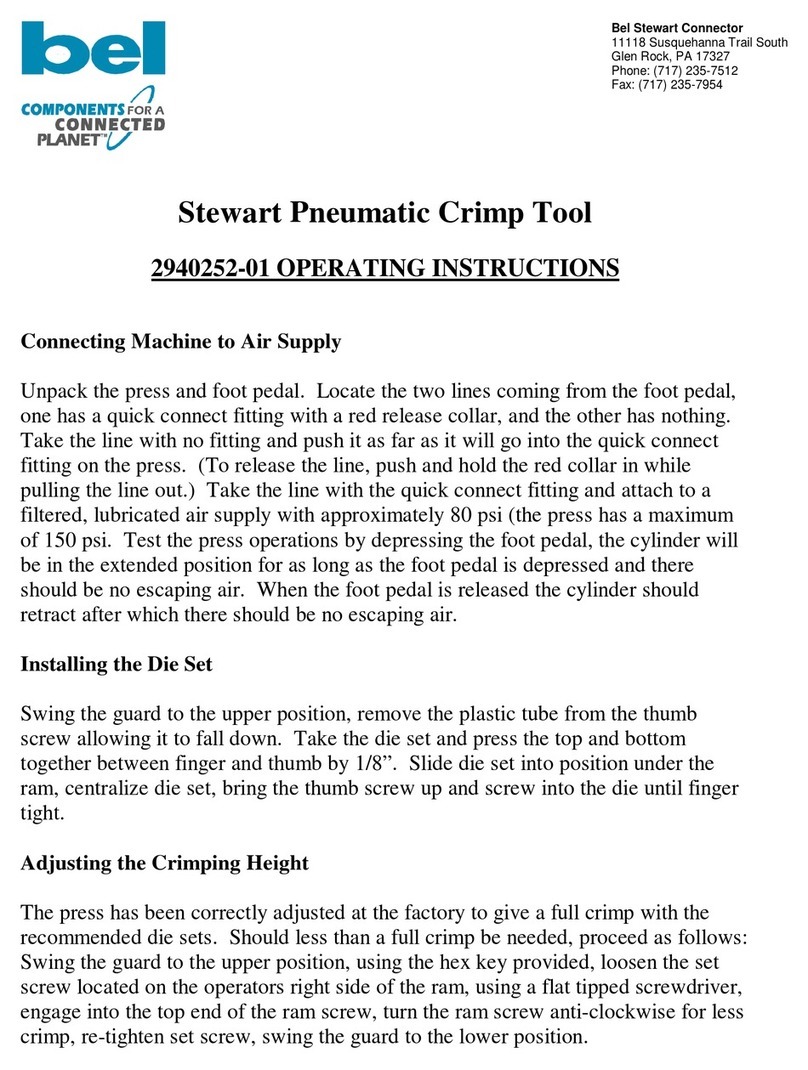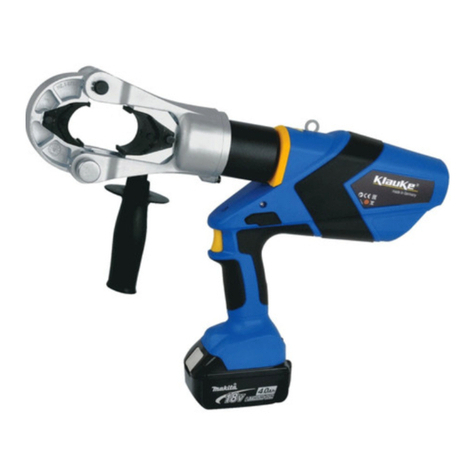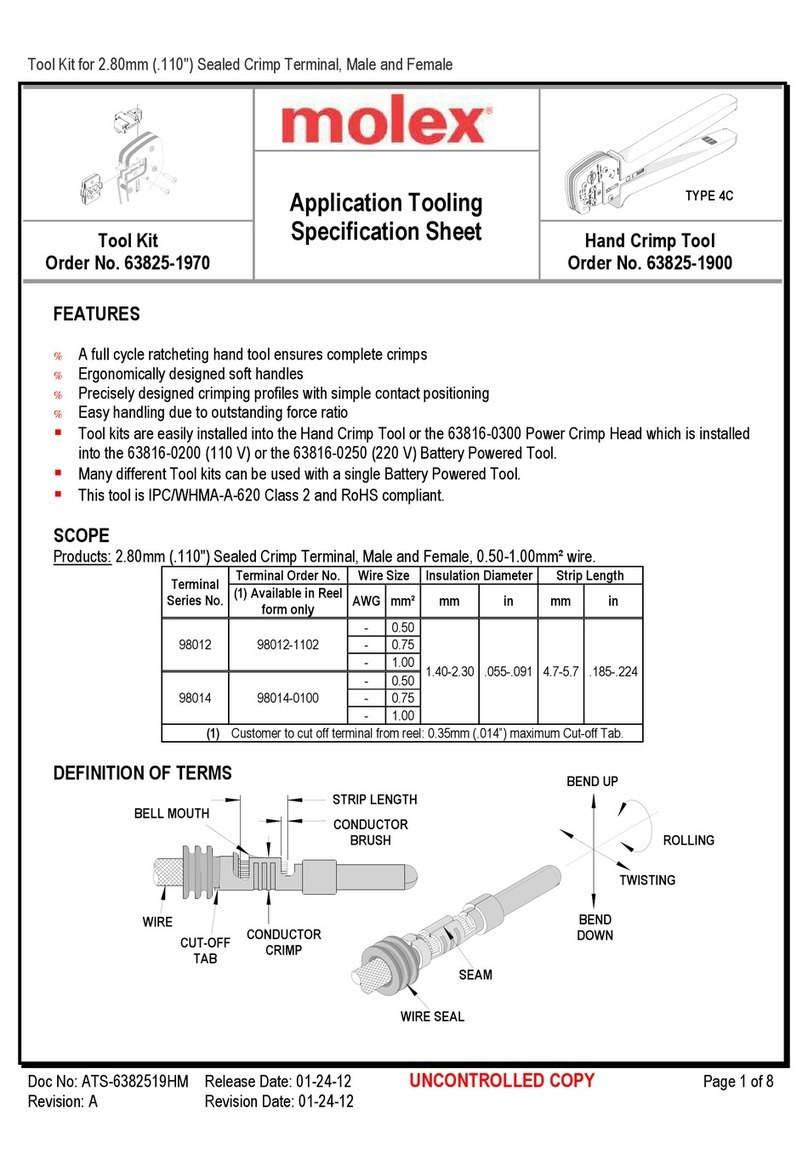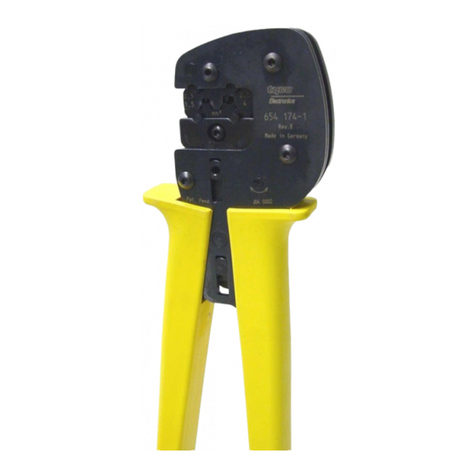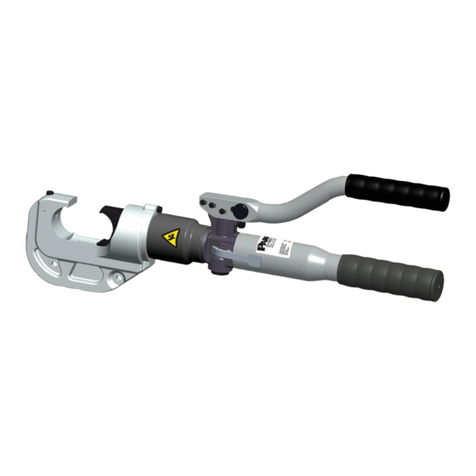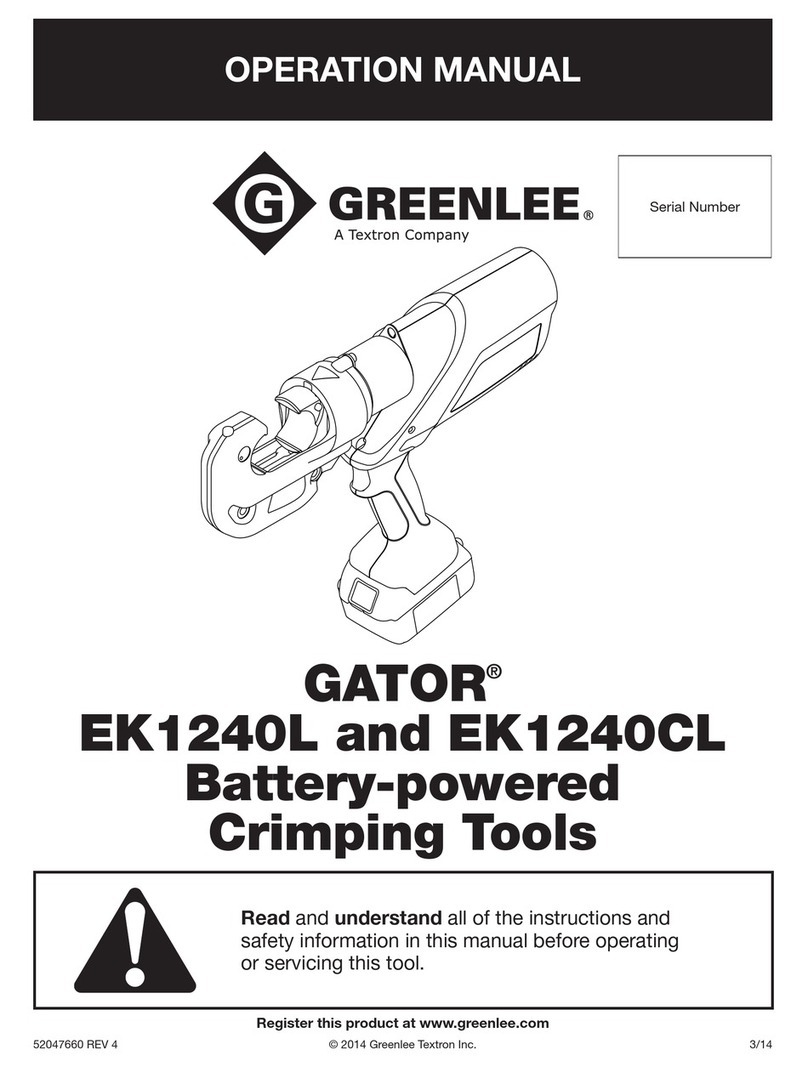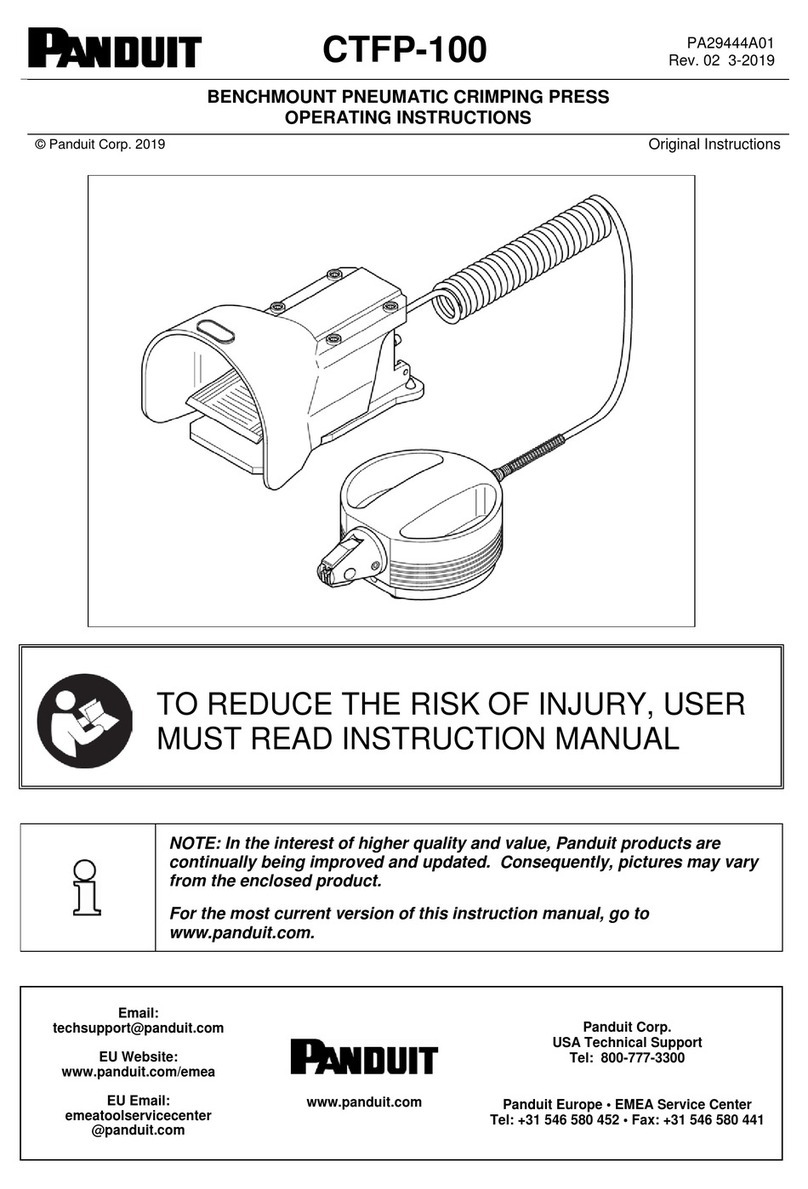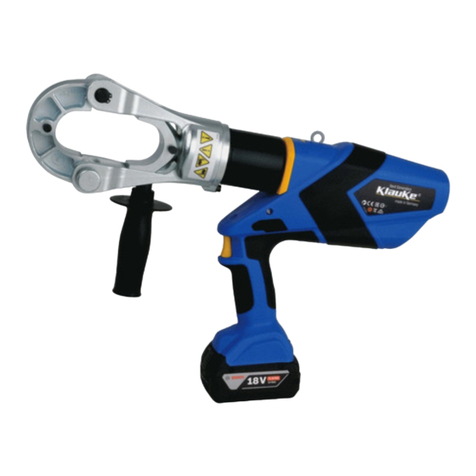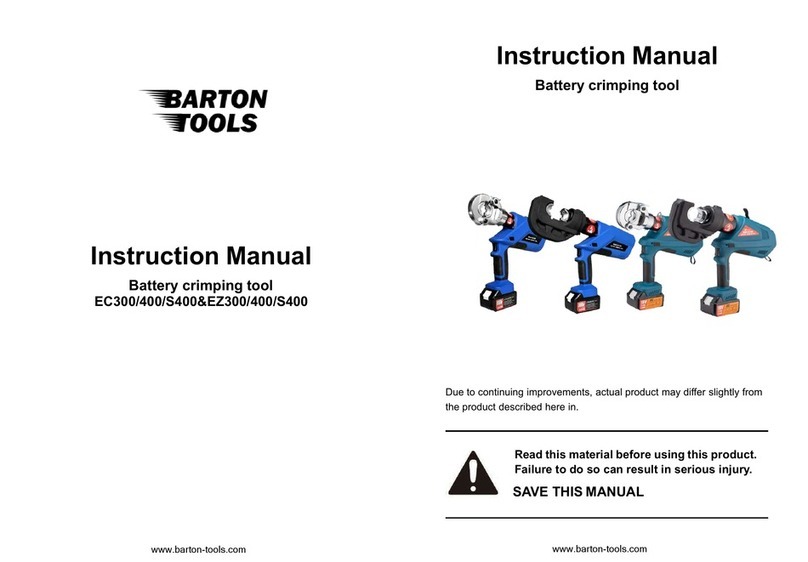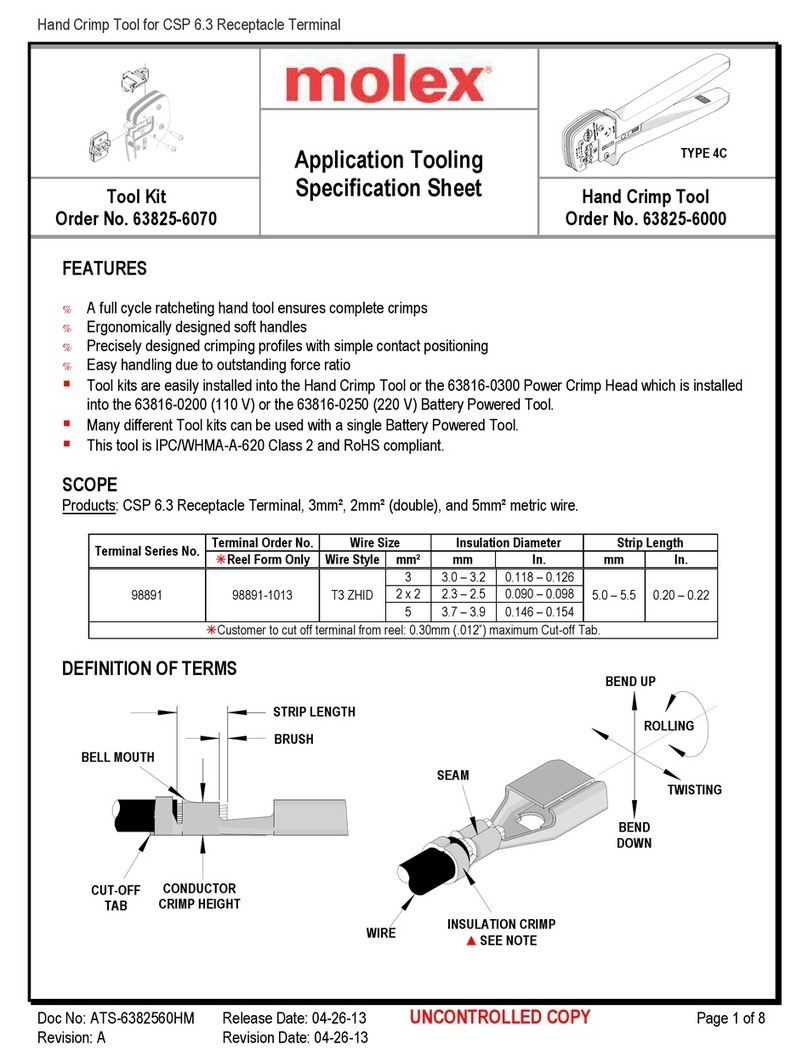Glomar EPG V P User manual

Bedienungsanleitung
Instruction Manual
EPG V P
GLOMAR AG
Bahnhofplatz, CH-9403 Goldach
Telefon: +41 71 841 70 70, Fax: +41 71 841 70 18
www.glomar.ch
__________________________________________________________________________________________________________________
__________________________________________________________________________________________________________________

Bedienungsanleitung EPG V P Seite 2
______________________________________________________________________________________________________________________
Bild/Picture 1
5
4
10
3
6
1
2
9
7
Bild/Picture 3
Bild/Picture 2
Preßkraft richtig Preßkraft zu hoch Preßkraft zu niedrig
GLOMAR AG, Bahnhofplatz, CH-9403 Goldach, Telefon: +41 71 841 70 70, Fax: +41 71 841 70 18, www.glomar.ch
__________________________________________________________________________________________________________________

Bedienungsanleitung EPG V P Seite 3
______________________________________________________________________________________________________________________
Bedienungsanleitung
für das elektro-hydraulische Preßgerät Typ EPG V P,
Seriennummer 126950WA1ff..
Inhaltsangabe
1 Einleitung
2 Aufschriften
3 Gewährleistung
4 Beschreibung des elektro-hydraulischen Preßgerätes
4.1 Beschreibung der Komponenten
4.2 Kurzbeschreibung der wesentlichen Leistungsmerkmale des
Gerätes
4.3 Beschreibung der Leuchtdiodenanzeige
5 Hinweise zum bestimmungsgemäßen Gebrauch
5.1 Bedienung des Gerätes
5.2 Erläuterung des Anwendungsbereiches
5.3 Verarbeitungshinweise
5.4 Wartungshinweise
5.5 Hinweis zur Verwendung des Akkus und des Ladegeräts
5.6 Aufbewahrung und Transport des Preßgerätes
6 Verhalten bei Störungen am Preßgerät
7 Außerbetriebnahme/Entsorgung
8 Technische Daten
Symbole
Sicherheitstechnische Hinweise
Bitte unbedingt beachten, um Personen-
und Umweltschäden zu vermeiden.
Anwendungstechnische Hinweise
Bitte unbedingt beachten, um Schäden am
Gerät zu vermeiden.
1. Einleitung
Vor Inbetriebnahme Ihres Preßgerätes
lesen Sie sich die Bedienungsanleitung
sorgfältig durch.
Benutzen Sie dieses Gerät ausschließlich für den
bestimmungsgemäßen Gebrauch.
Das Preßgerät darf nur durch eine elektrotechnisch unterwiesene
Person bedient werden. Das Mindestalter beträgt 16 Jahre.
Diese Bedienungsanleitung ist während der gesamten Lebensdauer
des Gerätes mitzuführen.
Der Betreiber muß
- dem Bediener die Betriebsanleitung zugänglich machen und
- sich vergewissern, daß der Bediener sie gelesen und verstanden
hat.
2. Aufschriften
Auf dem an dem Gehäuse angebrachten Typenschild finden Sie
Typbezeichnung, Herkunftsangabe und den Firmennamen. Auf der
gegenüberliegenden Seite des Gehäuses befindet sich ein
Aufkleber mit einer Kurzdarstellung der preßbaren Querschnitte
für Kupfer und Aluminium und der Preßkraft. Die Seriennummer
befindet sich auf dem Hydraulikzylinder zwischen dem Gehäuse
und dem Preßkopf. Am Preßkopf befindet sich ein Hinweis auf
eine mögliche Quetschgefahr bei Preßvorgängen und ein Hinweis
auf mögliche Fehler beim Verpressen.
3. Gewährleistung
Die Gewährleistung bei sachgemäßer Bedienung beträgt 12
Monate ab Lieferdatum.
4. Beschreibung des elektro-hydraulischen Preßgerätes
4.1. Beschreibung der Komponenten
Das elektro-hydraulische Preßgerät mit unserer Typbezeichnung
EPG V P ist ein handgeführtes Gerät und besteht aus folgenden
Komponenten:
Tabelle 1 (siehe Bild 1 Seite 2)
Pos.-
Nr.
Bezeichnung Funktion
1 Bedienungs-
schalter
Auslösung des Preßvorgangs
2 Rückstelltaste Taste zum Öffnen der Preßdorne im Fehler-,
bzw. Notfall
3 Bügel Bügel mit integriertem feststehendem
Preßdorn
4 Verschluß-
bolzen
Bolzen zum verschließen des Preßkopfes
5 Gehäuse Ergonomisch geformtes Kunststoffgehäuse
6 Leuchtdioden-
anzeige
Kontrollinstrument zum Feststellen des
Ladezustandes, eines Gerätefehlers und zur
Wartungsanzeige.
7 Akku wiederaufladbarer NiCd Akku
8 - -
9 Handschutz Bügel zum Schutz der bedienenden Hand,
kein Transportgriff!
10 Preßdorne 3 bewegliche und ein stationärer Preßdorn
4.2 Kurzbeschreibung der wesentlichen Leistungsmerkmale des Gerätes
- Das Gerät besitzt einen automatischen Rücklauf, der den Kolben nach
Erreichen der max. Preßkraft automatisch in die Ausgangslage
zurückfährt.
- Das Gerät ist mit einem Nachlaufstop ausgerüstet, der den Vorschub
nach Loslassen des Bedienungsschalters (Pos.-Nr. 1) sofort stoppt.
- Das Gerät ist mit einer Doppelkolbenpumpe ausgestattet, die durch
einen schnellen Vorschub und einen langsamen Arbeitshub
gekennzeichnet ist.
- Der Preßkopf ist stufenlos 360° um die Längsachse drehbar. Dieses
ermöglicht Montagen auch an sehr schlecht zugänglichen Stellen.
- Der Preßkopf besitzt Zentrierstifte, die ein automatisches Zentrieren
des Verbindungsmateriales im Preßkopf gewährleisten.
- Die EPG V P ist mit einer Mikroprozessor-Steuerung ausgestattet, die
den Motor nach vollendetem Preßvorgang abschaltet, Serviceinter-
valle anzeigt, den Ladezustand des Akkus (Pos.-Nr. 7) angibt und eine
Fehlerdiagnose durchführt.
4.3 Beschreibung der Leuchtdiodenanzeige
Die Leuchtdiode (Pos.-Nr. 6) dient in Verbindung mit der Steuerungs-
elektronik zur Information über den Zustand des Akkus (Pos.-Nr. 7) und
des Werkzeuges. Im einzelnen leuchtet die Diode in folgenden Fällen:
Signal Dauer Zeitpunkt Bedeutung
wenige Sekunden
Blinken
beim Einsetzen des
Akkus
Durchführung
des Selbsttests
20 Sekunden
Dauerleuchten
Nach dem
Arbeitsvorgang
Akku leer
1
20 Sekunden
Blinken (2Hz)
Nach dem
Arbeitsvorgang
Fehler oder
Wartung fällig
2
20 Sekunden
Blinken (5Hz)
Während der Dauer
der Übertemperatur
Gerät zu heiß
20 Sekunden
Leuchten und
Blinken
Nach dem
Arbeitsvorgang
Wartung fällig
und Akku leer
1Anmerkungen:
- Blinkt die Leuchtdiode ab einem bestimmten Zeitpunkt immer am Ende eines
Arbeitsvorgangs für etwa 20 Sekunden, dann ist eine Wartung fällig. Das Gerät ist
baldmöglichst ins Werk einzuschicken.
- Beim Auftreten eines Fehlers blinkt die Leuchtdiode gleichfalls am Ende eines
Arbeitszykluses. Das Blinken zeigt in diesem Fall das Ansprechen der
elektronischen Sicherung an. Eine mögliche Ursache dafür ist der Versuch, einen
Zyklus mit einem unzulässig entleerten Akku durchzuführen. Tritt das Blinken
auch nach Auswechseln des Akkus weiterhin auf, liegt eine andere Störung vor
oder eine Wartung ist fällig. In diesen Fällen ist das Gerät ins Werk einzuschicken.
2Wird das Gerät zu heiß schaltet sich das Gerät selbständig ab. Nach Absinken der
Temperatur ist das Gerät automatisch wieder einsatzbereit.
GLOMAR AG, Bahnhofplatz, CH-9403 Goldach, Telefon: +41 71 841 70 70, Fax: +41 71 841 70 18, www.glomar.ch
__________________________________________________________________________________________________________________

Bedienungsanleitung EPG V P Seite 4
______________________________________________________________________________________________________________________
5. Hinweise zum bestimmungsgemäßen Gebrauch
Vor Arbeitsbeginn sind alle aktiven, d.h. stromführenden Teile im
Arbeitsumfeld des Monteurs freizuschalten. Ist dieses nicht
möglich sind entsprechende Schutzvorkehrungen2für das Arbeiten
in der Nähe von unter Spannung stehenden Teilen zu treffen.
Es sollte vor Arbeitsbeginn der Ladezustand des Akkus (Pos.-Nr.
7) überprüft worden sein3. Ein niedriger Ladezustand kann
beispielsweise an der Leuchtdiode (Pos.-Nr. 6) durch ein 20 s’iges
Aufleuchten am Ende einer Pressung erkannt werden.
5.1. Bedienung des Gerätes
Zuerst wird der Verschlußbolzen (Pos.-Nr. 4) herausgezogen und
der Bügel (Pos.-Nr.3) aufgeklappt. Das Verbindungsmaterial wird
mittig zwischen den 4 Preßdornen positioniert.
Achtung
Bei einer außermittigen Verpressung kann es zu
Schäden an dem Preßkopf kommen!
Anschließend wird der Preßkopf wieder vollständig geschlossen.
Die Betätigung des Bedienungsschalters (Pos.-No. 1) leitet den
Preßvorgang ein, der durch das Zusammenfahren der Preßdorne
(Pos.-Nr. 10) gekennzeichnet wird (Bild 2 Bewegungsrichtung C).
Ein Preßvorgang ist abgeschlossen, wenn die Preßdorne (Pos.-Nr.
10) zusammengefahren sind. Der Rücklauf des Kolbens erfolgt
automatisch nach Erreichen des max. Betriebsüberdruckes.
Anschließend kann ein weiterer Preßvorgang vorgenommen
werden oder durch Öffnen des Bügels (Pos.-Nr. 3) das
Verbindungsmaterial aus dem Preßkopf herausgenommen werden.
Achtung
Vor Eingriff in den Preßkopf Akku gegen
unbeabsichtigtes Betätigen aus dem Gerät
entfernen.
Durch Drücken der Rückstelltaste (Pos.-Nr. 2) können im Fehler-,
bzw. Notfall die Preßdorne in die Ausgangsposition zurück-
gefahren werden (Bild 2 Stellung B).
Achtung
Der Preßvorgang kann jederzeit durch Loslassen
des Betätigungsschalters unterbrochen werden.
5.2. Erläuterung des Anwendungsbereiches
Das Preßgerät verfügt über Preßdorne (Pos.-Nr. 10), die kraft-
gesteuert ohne Werkzeugwechsel Dr. PetersCu- und Al-
Verbindungsmaterial verpressen können.
Tabelle 2
Verbindungsmaterial Preßbereich
RKS +Vb “Normalausführung” +
RKS für Schaltgeräte-Anschlüsse
16 –300 mm²
RKS für feindrähtige Leiter 16-300 mm²
Andere Anwendungen auf Anfrage.
Abkürzungen: RKS – Rohrkabelschuhe, Vb – Verbinder,
QKS – Quetschkabelschuhe
Achtung
Es dürfen nur die in Tab. 2 genannten
Verbindungsmaterialien verpreßt werden.
2Siehe DIN EN 50110-1
3siehe Kapitel 5.5
Sollten andere Verbindungsmaterialien verpreßt werden müssen, ist eine
Rücksprache mit dem Werk zwingend erforderlich.
Achtung
Es dürfen keine unter Spannung stehenden Teile
verpreßt werden.
Bei der EPG V P handelt es sich um ein handgeführtes Gerät, das nicht
eingespannt werden darf. Es darf nicht für den stationären Einsatz
verwendet werden. UnterEinhaltung bestimmter Bedingungen kann das
Gerät auch stationär mit unserem Präsentationsständer EKST betrieben
werden. Die Bedingungen entnehmen Sie bitte der Bedienungsanleitung
des EKST.
Das Gerät ist nicht für den Dauerbetrieb geeignet. Es muß nach ca. 30-
40 Verpressungen hintereinander eine Pause von ca. 15 min eingelegt
werden, um das Gerät abzukühlen.
Achtung
Bei zu intensivem Gebrauch kann es durch Erhitzung zu
Schäden am Gerät kommen.
Achtung
Beim Betrieb von Elektromotoren kann es zur
Funkenbildung kommen, durch die feuergefährliche oder
explosive Stoffe in Brand gesetzt werden können.
Achtung
Das elektrohydraulische Preßgerät darf nicht bei starkem
Regen oder unter Wasser eingesetzt werden.
5.3. Verarbeitungshinweise
Um die Einhaltung der erforderlichen Preßkraft des Werkzeuges zu
überprüfen, ist als Zubehör eine Lehre (15466) und Prüfzylinder (15465)
erhältlich. Die Prüfzylinder müssen mittig in axialer Richtung in den
Preßkopf eingelegt und verpreßt werden. Anhand der Längen-änderung
des Prüfzylinders kann eine Aussage über die aktuelle Preßkraft
getroffen werden. (siehe Bild 3) Sind die Prüfzylinder ohne
Berücksichtigung der Verwerfungen zu lang oder zu kurz muß das
Werkzeug neu eingestellt werden.
Bitte beachten Sie unbedingt die im Katalog Kapitel 12 angeführten
Montagehinweise.
5.4. Wartungshinweise
Das Preßgerät ist weitestgehend wartungsfrei. Nach 10.000
Verpressungen ist eine Wartung4fällig, die über die Leuchtdiode (Pos.-
Nr. 6) angezeigt wird. Es ist nach jedem Gebrauch zu reinigen und
trocken zu lagern. Sowohl Akku als auch Ladegerät müssen vor
Feuchtigkeit und vor Fremdkörpern geschützt werden.
Im Rahmen des bestimmungsgemäßen Gebrauchs darf vom Kunden nur
der Akku (Pos.-Nr. 7) gewechselt werden.
Achtung
Geräteversiegelung nicht beschädigen!
Bei Beschädigung der Geräteversiegelung erlischt der Garantieanspruch.
Zur Kontrolle der erforderlichen Preßkraft kann über einen Meßadapter
(Art.-Nr. MAVP) in Verbindung mit unserem digitalem Anzeigegerät
TC1 die tatsächliche Preßkraft exakt ermittelt werden.
5.5. Hinweis zur Verwendung des Akkus und des Ladegerätes
Das Ladegerät ist für 230 V/50-60 Hz ausgelegt. Neue Akkus müssen
vor dem erstmaligen Gebrauch geladen werden. Zur Aufladung des
Akkus wird der Stecker des Ladegerätes in die Steckdose und der Akku
in das Ladegerät eingesteckt. Die Ladezeit beträgt ca. eine Stunde. Der
Ladezustand des Akkus5wird an der Leuchtdiode am Ladegerät
abgelesen.
4siehe Kap. 4.3
5Der Ladezustand des Akkus kann auch an der LED des Gerätes durch
Leuchten am Ende einer Pressung erkannt werden. Siehe Kap. 4.3.
GLOMAR AG, Bahnhofplatz, CH-9403 Goldach, Telefon: +41 71 841 70 70, Fax: +41 71 841 70 18, www.glomar.ch
__________________________________________________________________________________________________________________

Bedienungsanleitung EPG V P Seite 5
______________________________________________________________________________________________________________________
grün: Akku ist aufgeladen
rot: Akku wird gerade geladen.
blinken: Akku nicht vollständig eingeschoben oder Akku
zu heiß, ein akustisches Signal ertönt.
Ist der Ladevorgang abgeschlossen wechselt das Ladelicht wieder
auf grün, wobei gleichzeitig ein akustisches Signal 5 Sekunden
lang ertönt.
Es dürfen keine artfremden Akkus weder in dem Preßgerät noch
im Ladegerät verwendet werden.
Laden Sie Ihren Akku auf, sobald die Geschwindigkeit Ihrer
Maschine merklich nachläßt, bzw. die Anzeige am Gerät (siehe
Kap. 4.3) auf einen leeren Akku hinweist. Laden Sie nicht
vorsichtshalber einen teilentladenen Akku nach.
Wenn Sie einen Akku aus einem kürzlich betriebenen Gerät oder
einen, der längere Zeit in der Sonne lag, laden, kann das
Aufladelicht rot blinken. Warten Sie in diesem Fall eine Weile.
Das Aufladen beginnt nach Abkühlung des Akku.
Blinkt das Aufladelicht abwechselnd rot und grün und wird ein
Warnsignal 20 sec. lang abgegeben, ist das Aufladen nicht
möglich. Die Pole des Ladegerätes oder die des Akkus sind durch
Staub verschmutzt oder der Akku ist verbraucht oder beschädigt.
Wollen Sie zwei Akkus nacheinander aufladen, warten Sie 15 min
bevor Sie den zweiten Akku laden.
Laden Sie den Akku bei einer Raumtemperatur von 10°C bis 40°C.
Lassen Sie das Ladegerät nie im Regen oder Schnee liegen. Laden
Sie den Akku nicht in Anwesenheit leicht entzündbarer Stoffe oder
Gase.
Tragen Sie das Ladegerät nie am Netzkabel und ziehen Sie es nicht
gewaltsam aus der Steckdose heraus. Stecken Sie keine fremden
Gegenstände in die Lüftungsgitter des Ladegerätes.
Das Laden der Akkus darf nur in den vom Hersteller
vorgeschriebenen Ladegeräten vorgenommen werden.
Achtung
Stecken Sie den Akku nicht in Ihre Hosentasche
oder in Ihre Werkzeugkiste, wenn sich in ihnen
leitfähige Teile befinden, wie z.B. Münzen,
Schlüssel, Werkzeuge oder andere metallische Teile.
Ziehen Sie den Stecker des Ladegerätes nach dem Laden aus der
Steckdose heraus. Nehmen Sie das Ladegerät nicht auseinander.
Um die Sicherheit und Zuverlässigkeit des Ladegerätes zu gewähr-
leisten sollten Reparatur, Wartung oder Einstellung durch unser
Service-Center durchgeführt werden.
5.6. Aufbewahrung und Transport des Preßgerätes
Um das Preßgerät vor Beschädigungen zu schützen, muß es nach
Gebrauch und nachdem es gesäubert worden ist, in den Transport-
koffer gelegt werden, der dann anschließend sicher zu verschließen
ist.
6. Verhalten bei Störungen am Preßgerät
a.) Regelmäßiges Blinken der Leuchtdiodenanzeige (Pos.-Nr. 6)
=> Akku (Pos.-Nr. 7) austauschen. Leuchtet die Anzeige weiter,
muß das Gerät eingeschickt werden. (siehe auch Kap. 4.3)
b.) Das Preßwerkzeug verliert Öl.
=> Das Gerät einschicken. Das Gerät nicht öffnen und die
Geräte-versiegelung nicht entfernen.
c.) Preßwerkzeug erreicht den Enddruck nicht.
=> Preßvorgang unterbrechen. Rückstelltaste (Pos.-Nr. 2)
gedrückt halten und gleichzeitig Bedienungsschalter ca. 10 sec.
Dauerbetätigen. Wird der Fehler dadurch nicht behoben, muß
das Gerät ins Werk eingeschickt werden.
7. Außerbetriebnahme/Entsorgung
Die Entsorgung der einzelnen Komponenten des Aggregates muß
getrennt erfolgen. Dabei muß zuerst das Öl abgelassen werden und an
speziellen Abnahmestellen entsorgt werden.
Achtung
Hydrauliköle stellen eine Gefahr für das Grundwasser
dar. Unkontrolliertes Ablassen oder unsachgemäße
Entsorgung steht unter Strafe. (Umwelthaftungsgesetz)
Anschließend muß der Akku (Pos.-Nr. 7) unter Berücksichtigung der
Batterieverordung speziell entsorgt werden.
Bei der Entsorgung der restlichen Teile des Aggregates beachten Sie
bitte die Umweltstandards der Europäischen Gemeinschaft, respektive
der in Ihrem Land geltenden Vorschriften.
Wir empfehlen wegen möglicher Umweltverschmutzung die Entsorgung
durch zugelassene Fachunternehmen vornehmen zu lassen. Eine
kostenfreie Rücknahme des Altgerätes durch den Hersteller kann nicht
zugesagt werden.
8. Technische Daten
Gewicht des kompl. Gerätes: ca. 5,1 kg (inklusive Akku)
Antriebskraft: ca. 55 kN
Antriebsmotor: Gleichstrom-Permanentfeldmotor
Akkuspannung: 12 V
Akkukapazität: 2 Ah
Akku-Ladezeit: ca. 1 h [LG 1], bzw. ¼ h [LG2]
Preßzeit: ca. 5 s
Pressungen pro Akku: ca. 150 Pressungen
(Cu 150 mm² DIN 46235)
Hydrauliköl: ca. 65 ml "AVIA HVI 15"
Umgebungstemperatur: -20°C bis +40°C
Schalldruckpegel: 75 dB (A) in 1m Abstand
Vibrationen: < 2,5 m/s²
(gewichteter Effektivwert der
Beschleunigung)
Maße: Siehe Bild 2
Anmerkung
Diese Bedienungsanleitung kann jederzeit kostenlos unter der Bestell-
Nr. HE.7413 nachbestellt werden.
GLOMAR AG, Bahnhofplatz, CH-9403 Goldach, Telefon: +41 71 841 70 70, Fax: +41 71 841 70 18, www.glomar.ch
__________________________________________________________________________________________________________________

Instruction Manual EPG V P page 6
______________________________________________________________________________________________________________________
Instruction Manual
for the electric-hydraulic crimping unit Type EPG V P,
Serial-No. 126950WA1ff..
Index
1 Introduction
2 Labels
3 Warranty
4 Description of the electric-hydraulic crimping unit
4.1 Description of the components
4.2 Brief description of the important features of the unit
4.3 Description of the light diode display
5 Remarks in respect of the determined use
5.1 Operation of the units
5.2 Explanation of the application range
5.3 Mounting instructions
5.4 Service and Maintenance instructions
5.5 Remarks on the use of the Battery Cartridge and Charger
5.6 Storage and transport of the crimping unit.
6 Troubleshooting
7 Putting out of operation/waste disposal
8 Technical data
Symbols
Safety warnings
Please do not disregard these instructions in order to
avoid human injuries and environmental damages.
Operational warnings
Please do not disregard them to avoid damaging the
pump unit.
1. Introduction
Before starting to use the tool please read the
instruction manual carefully.
Use this tool exclusively for its determined use.
Mounting and assembly of connecting material with the help of
this tool must only be performed by specially trained personnel.
The minimum age is 16 years.
This instruction manual has to be carried along during the entire
life span of that tool.
The operator has
- to guaranty the availability of the instruction manual for the user
and
- to make sure, that the user has read and understood the
instruction manual.
2. Labels
On the labels fixed on the housing of the tool you’ll find the type
specification name of the manufacturer and the company logo. On
the opposite side of the housing you’ll find a label with a brief
presentation of the scope of manageable cross-sections for copper
and aluminium and the pressing force. The serial number is on the
hydraulic cylinder between the housing and the crimping head. On
the crimping head you’ll find a warning against possible injuries
during the crimping process and against crimping errors.
3. Warranty
If correct operation is guaranteed our warranty is 12 months from
the time of delivery.
4. Description of the electric-hydraulic crimping unit
4.1. Description of the components
The electric-hydraulic crimping unit type EPG V P is a hand held
tool and consists of the following components:
Table 1 (see Picture 1 page 2)
Pos.-
No.
Description Function
1 Trigger switch to start crimping procedure
2 Retract
button
button to retract the indenters in case of error
or emergency
3 Latch Latch with integrated indenter
4 Locking pin Pin neccessary to close the crimping head
5 Housing ergonomically formed plastic housing for
perfect handling with a detachable lid
6 Light diode
display
indicator for tool functions and battery
charge control
7 Battery
cartridge
rechargeable NiCd battery
8 - -
9 Removable
hand guard
guard to protect the operating hand, not for
transportation
10 Indenter 3 moving and 1 stationary indenter
4.2. Brief description of the important features of the unit
- The hydraulic unit incorporates an automatic retraction which returns
the indenters into its starting position when the maximum operating
pressure is reached.
- The unit is equipped with a special brake which stops the forward
motion of the indenters when the trigger (Pos.-No. 1) is released.
- The unit is equipped with a double piston pump which is characterised
by a rapid approach of the indenters (Pos.-No. 10) towards the
connector and a slow crimping motion.
- The crimping head can be smoothly turned by 360° around the
longitudinal axis in order to gain better access to tight corners and
other difficult working areas.
- The crimping head incorporates guiding mechanism, respectively
centering pins, which provide an automatic centering of the
connecting material in the crimping head.
- The EPG V P is equipped with a microprocessor which indicated
service intervals, internal checks and low battery charges. It also shuts
off the motor automatically after the crimp is completed.
4.3. Description of the light diode display
This tool is equipped with a special circuit board incorporating several
important features to inform the user about the current status of the unit.
The diode (Pos.-No. 6) signals in the following cases:
Signal Duration When it
occures
What it means
a few seconds of
flashing
battery
insertion
self check – O.K.
glowing for
20 seconds
after crimp battery discharged
1
flashing for
20 seconds (2Hz)
after crimp return for service
2
flashing for
20 seconds (5Hz)
During high
temperature
unit too hot
20 sec. glowing
and flashing
intermittently
after crimp service required
and battery flat
1Remarks:
- Does the diode signal periodically at the end of a working cycle for
approx. 20 sec the unit must be returned to an authorised Service Center
for Service as soon as possible.
- In case of an error the light diode display also signals periodically at the
end of a working cycle. The signal indicates in this case the circuit opening
by the electronic fuse. A possible reason for that is that a cycle was
performed with an incorrectly low battery. If the signal occurs even after
changing the battery there must be a different error or a service is due. In
these cases the tool must be returned to the manufacturer or an authorised
service center.
2The unit switches off when it gets too hot. It switches on automatically
after the unit cooled off.
GLOMAR AG, Bahnhofplatz, CH-9403 Goldach, Telefon: +41 71 841 70 70, Fax: +41 71 841 70 18, www.glomar.ch
__________________________________________________________________________________________________________________

Instruction Manual EPG V P page 7
______________________________________________________________________________________________________________________
5. Remarks in respect of the determined use
Before starting any work on electrical appliances it must be
safeguarded that there are no live parts in the immediate assembly
area of the user. Is this not possible special precaution measures1
for working near live parts must be provided.
Prior to operating the unit the charging level of the battery (Pos.-
No. 7) should have been tested2. A low charging level can be
detected by the flashing of the LED (Pos.-No. 6) for 20 s at the end
of a crimping cycle.
5.1. Operation of the unit
First the crimping head must be opened by pulling out the locking
pin (Pos.-No. 4) and removing the latch (Pos.-No. 3). The
connecting material must be positioned right in the center of the
four indenters.
Attention
If the connector is crimped in an out-of-center
position the crimping head can damaged.
The crimping head has to be opened by unhooking the latch (Pos.-
No. 3 & Picture 2 Pos. A).
The crimping procedure is initiated by actuating the trigger (Pos.-
No. 1 & Picture 2 Pos. C). The crimping process is defined by the
closing motion of the indenters.
The crimping process is terminated when the crimping force is
reached. After having completed the crimp the indenters return into
the starting position automatically. Afterwards a second crimping
cycle can be initiated or the it can be finished by opening the latch
(Pos.-No. 3 & Picture 2 Pos. A).
Attention
Before approaching the crimping head with
your hands and fingers remove battery to
avoid unintended use.
In case of error or emergency the indenters can be returned into the
starting position by actuating the retract button (Pos.-No. 2 &
Picture 2 Pos. B).
Attention
The crimping process can be interrupted at any
moment by releasing the trigger.
5.2. Explanation of the application range
Our electric hydraulic crimping unit is a dieless crimper supplied
with four indenters to crimp primarily Dr. Peters copper and
aluminium cable lugs and connectors.
Table 2
Connectingmaterial Range
TCL + Connectors “Standardversion” +
TCL for switchgear connections
16 –300 mm²
TCL for fine str. cables/conductors 16-300 mm²
Other applications upon request.
Abbreviation: TCL – Tubular cable lugs
Attention
Do only crimp those connecting materials
mentioned in Tab. 2
If different conducting materials have to be crimped, please
contact the manufacturer.
1See EN 50110-1
2See Chapter 5.5 for more information of the battery and charging unit
Attention
Do not crimp on live cables or conductors
The EPG V P is a hand held tool and it is not supposed to be restrained
in a vise. It is not allowed to use the tool in a stationary application.
Complying certain conditions the unit can be operated stationary with
our presentation support EKST. The conditions can be taken from the
instruction manual of the EKST.
The tool is not designed for continued crimping operations. After a
sequence of approximately 30-40 completed crimps you have to make a
break of 15 min. to give the tool time to cool down.
Attention
Too intensive use can cause heat damages for the tool
Attention
During the operation of electric engines sparks can occur
which might ignite highly inflammable or explosive
liquids and materials
Attention
Electric-hydraulic crimping tools should not be operated
in pouring rain or under water.
5.3. Mounting instructions
In order to guaranty the required crimping force the user can order a
special gauge (15466) and test slugs (15465). The slug must be centered
in the crimping head and crimped in axial direction. The difference in
length provides information about the actual crimping force of the tool.
(Pls. see picture 3) If the slugs are too long or too short the tool must be
re-adjusted.
Please read the assembly instructions in Chapter 12 of our general
catalogue.
5.4 Service and maintenance instruction
The electric-hydraulic crimping unit is equipped with a controller
enabling the user to see when the next service is due. (Pls. read chapter
4.3 for more information) When the next service is due the unit must be
returned to an authorised service center.
For every day service the unit has to be cleaned and dried after each use.
The battery cartridge (Pos.-No. 7) and the charging unit have to be
protected against humidity and dust.
Within the determined use of the tool only the batteries (Pos.-No. 7) are
permitted to be changed by the customers.
Attention
Do not damage the seals of the tool.
If the seals are damaged the warranty is invalidated.
In order to check the required crimping force of the tool use our
measuring adapter (Part.-No. MAVP) with our digital meter TC 1 to
determine the exact actual crimping force.
5.5 Remarks on the use of the battery cartridge and charging unit.
The charging unit is run with a nominal voltage of 230 V and a
frequency of 50-60 Hz. New batteries must be charged prior to use. To
charge the battery cartridge (Pos.-No. 7) the power plug of the charging
unit has to be plugged into the power supply and the battery cartridge
has to be pushed into the charging unit. The charging time is one hour.
The charging level of the battery cartridge can be checked by a LED4.
green battery cartridge is charged
red Battery cartridge is empty and is just being charged
flashing battery cartridge is not pushed in properly or too hot,
a sound signal occurs
4The charging level of the battery can also be verified by the LED of the
tool at the end of a crimping cycle. See chapter 4.3 for further information.
GLOMAR AG, Bahnhofplatz, CH-9403 Goldach, Telefon: +41 71 841 70 70, Fax: +41 71 841 70 18, www.glomar.ch
__________________________________________________________________________________________________________________

Instruction Manual EPG V P page 8
______________________________________________________________________________________________________________________
Is the battery plugged in correctly the LED changes from green to
red and the charging procedure starts. When the charging
procedure is terminated the LED changes again to green.
Simultaneously a signal occurs for 5 seconds.
No other battery cartridges e.g. dry batteries or car batteries etc. are
permitted to be used neither in the tool nor in the charging unit.
As soon as the speed of the machine decreases noticeably the
battery must be recharged. Do not recharge a partially discharged
battery as a precaution.
If charging a battery which has currently been used or which was
laying in the sun for a longer period of time the LED might flash
red. In this case wait for a while. The charging procedure starts
after the battery cooled down.
Does the LED flash red and green and does an audible tone occur
for 20 seconds it is not possible to charge that battery. The poles of
the battery or the charging unit are dirty or the battery is low or
damaged. If you want to charge two batteries in a row wait for 15
min before you charge the second battery.
Avoid great fluctuating temperatures under 0°C and above 40°C.
Through these fluctuations damages may result for the battery
cartridge as well as for the charging unit. The best operation
temperature is between 15-25 °C.
Do not leave or operate the charging unit in rain or snow. Do not
charge the battery near lightly inflammable materials or gases.
Do not use the cord to transport the charging unit or to pull the
plug out of a wall socket with force. Do not insert strange parts
into the ducts of the charging unit.
The charging of the batteries must only be done with charging
units supplied by the manufacturer.
Attention
Do not place the battery in your pocket or in your
toolbox if there are any conductive materials in it
such as coins, keys, tools or other metallic parts.
Pull the plug of the charging unit after charging. Do not
disassemble the charging unit or battery.
In order to safeguard a safe and proper performance of the
charging unit the repair and service of the unit should be made
through our Service Center.
5.6 Storage and transport of the crimping tool
In order to protect the tool against damages it has to be cleaned
carefully after each use and be put into the transportation case
which has to be closed safely.
6. Troubleshooting
a.) Flashing of the light diode display (Pos.-No. 6)
=> See chapter 4.3 for more information about the special
functions of the tool.
b.) The tool loses oil.
=> Return the tool to the manufacturer. Do not open the tool and
damage the seals of the tool.
c.) The crimping tool does not reach the final operating pressure.
=> Stop the crimping process. Press the retract button (Pos.-No.
2) and the operating switch continuously and simultaneously for
about 10 sec. Is the malfunction not be eliminated by this
attempt the tool has to be returned to the manufacturer.
7. Putting out of operation/waste disposal
The disposal of the various components of the tool has to be treated
separately. First you have to dispose of the oil at special delivery points.
Attention
Hydraulic oils represent a danger for the ground-water.
Uncontrolled draining of or improper disposal is under
penalty. (environmental liability law)
Next, the battery cartridge (Pos.-No. 7) has to be specially disposed of
according to the EEC Battery Guideline.
For the disposal of the remaining parts please reference the EC
environmental guideline.
Because of possible environmental damages we recommend to dispose
of the tool by professional companies. A return of the old tool free of
charge to the manufacturer cannot be granted.
8. Technical Data
Weight of the complete tool: approx. 5,1 kg (incl. battery)
Drive force: approx. 55 kN
Driving motor: direct-current permanent field motor
Battery voltage: 12 V
Battery capacity 2 Ah
Charging time: approx. 1 h, ¼ h with Quickcharger
Crimping time: approx. 5 s
Crimp per battery: approx. 150 crimps
(Cu 150 mm² DIN 46235)
Hydraulic oil: approx. 65 ml "AVIA HVI 15"
Environmental temperature: -20°C to –40°C
Sound level: 75 dB (A) in 1m distance
Vibrations: < 2,5 m/s²
Dimensions: See Picture 2
Additional instruction manuals are available free of charge. The part # is
HE.7413.
GLOMAR AG, Bahnhofplatz, CH-9403 Goldach, Telefon: +41 71 841 70 70, Fax: +41 71 841 70 18, www.glomar.ch
__________________________________________________________________________________________________________________

Dr. PetersGmbH Auf dem Knapp 57
D-42855 Remscheid
__________________________________________________________________________________________________________________
Handgeführtes Elektrowerkzeug Typ EPG V P
(D) CE `99 - Konformitätserklärung. Wir erklären in alleiniger Verantwortlichkeit, daß dieses Produkt mit den folgenden Normen oder
normativen Dokumenten übereinstimmt:
DIN EN 292 Teil 1 und 2, EN 294, EN 349, EN 60204-1, EN 28662-1, EN 50081-1, EN 50082-2, EN 60529
gemäß den Bestimmungen der Richtlinien 89/392/EWG, 89/336/EWG
(GB) CE `99 - Declaration of conformity. We declare under our sole responsibility that this product is in conformity with the following standards
or normative documents:
DIN EN 292 Teil 1 und 2, EN 294, EN 349, EN 60204-1, EN 28662-1, EN 50081-1, EN 50082-2, EN 60529
in accordance with the regulations of directives 89/392/EEC, 89/336/EEC
(F) CE `99 - Déclaration de conformité. Nous déclarons sous notre seule reponsabilité que ce produit est en conformité avec les normes ou
documents normatifs suivants:
DIN EN 292 Teil 1 und 2, EN 294, EN 349, EN 60204-1, EN 28662-1, EN 50081-1, EN 50082-2, EN 60529
conformément aux réglementations des directives 89/392/CEE, 89/336/CEE
(NL) CE `99 - Konformiteitsverklaring. Wij verklaren en wij stellen ons er alleen voor verantwoordelijk dat dit produkt voldoet aan de volgende
normen of normatieve documenten:
DIN EN 292 Teil 1 und 2, EN 294, EN 349, EN 60204-1, EN 28662-1, EN 50081-1, EN 50082-2, EN 60529
overeenkomstig de bepalingen van de richtlijnen 89/392/EEG, 89/336/EEG
(I) CE `99 - Dichiarazione di conformità. Dichiariamo sotto la nostra esclusiva responsabilità
che questo prodotto è conforme alle seguenti norme e documenti normativi:
DIN EN 292 Teil 1 und 2, EN 294, EN 349, EN 60204-1, EN 28662-1, EN 50081-1, EN 50082-2, EN 60529
conformemente alle disposizioni delle direttive 89/392/CEE, 89/336/CEE
(E) CE `99 - Declaración de conformidad. Declaramos bajo nuestra sola responsabilidad que este producto està en conformidad con las normas o
documentos normativos siguientes:
DIN EN 292 Teil 1 und 2, EN 294, EN 349, EN 60204-1, EN 28662-1, EN 50081-1, EN 50082-2, EN 60529
de acuerdo con las regulaciones de las directivas 89/392/CEE, 89/336/CEE
(P) CE `99 - Declaração de conformidade. Declaramos sob nossa exclusiva responsabilidade que este producto cumpre as seguintes normas ou
documentos normativos:
DIN EN 292 Teil 1 und 2, EN 294, EN 349, EN 60204-1, EN 28662-1, EN 50081-1, EN 50082-2, EN 60529
conforme as disposiçoes das directivas 89/392/CEE, 89/336/CEE
(S) CE `99 - Konformitetsdeklaration. Vi förklarar pá eget ansvar att denna produkt õverenstämmer med följande normer eller normativa
dokument:
DIN EN 292 Teil 1 und 2, EN 294, EN 349, EN 60204-1, EN 28662-1, EN 50081-1, EN 50082-2, EN 60529
enligt bestãmmelserna i direktiverna 89/392/EG, 89/336/EG
(FIN) CE `99 - Todistus slandardinmukaisuudesta. Asiasta vastaavana todistamme täten, että tämä tuote on seuraavien standardien ja
standardoimisasiakirjojen vaatimusten mukainen:
DIN EN 292 Teil 1 und 2, EN 294, EN 349, EN 60204-1, EN 28662-1, EN 50081-1, EN 50082-2, EN 60529
ja vastaa säädoksiä 89/392/EU, 89/336/EU
(N) CE `99 - Konformitetserklæring. Vi erklærer på eget ansvarlighet at dette produkt er i overensstemmelse med følgende standarder eller
standard-dokumenter:
DIN EN 292 Teil 1 und 2, EN 294, EN 349, EN 60204-1, EN 28662-1, EN 50081-1, EN 50082-2, EN 60529
i henhold til bestemmelsene i direktive ne 89/392/EØF, 89/336/EØF
(DK) CE `99 - Konformitetserklæring. Vi erklærer under almindeligt ansvardt at dette produkt er i overensstemmelse med folgende normer eller
normative dokumenter:
DIN EN 292 Teil 1 und 2, EN 294, EN 349, EN 60204-1, EN 28662-1, EN 50081-1, EN 50082-2, EN 60529
i henhold til bestemmelseme i direktiverne 89/392/EØF, 89/336/EØF
(PL) CE `99 - Zgodnosc z dyrektywami CE. Swiadomi odpowiedzialnosci oswiadczamy, ze niniejszy produkt jest zgodny z nastepujacymi
normami lub dokumentacja normatywna:
DIN EN 292 Teil 1 und 2, EN 294, EN 349, EN 60204-1, EN 28662-1, EN 50081-1, EN 50082-2, EN 60529
zgodnie z postanowieniami wytycznych 89/392/EWG, 89/336/EWG
(GR) CE `99 - ∆ΗΛΩΣΗ ΣΥΜΜΟΡΦΩΣΗΣ Με αναληψη συνολικης δηλωνοµε. οτι το πορον προιον συµϕωνει µε τα παρακατω
ποοτυπα και µε τα ηροτυηα ηου αναϕερονται στα σχεπκο εγγραϕα
DIN EN 292 Teil 1 und 2, EN 294, EN 349, EN 60204-1, EN 28662-1, EN 50081-1, EN 50082-2, EN 60529
συµϕωνα µε τοχς κονονισµους 89/392/EEC, 89/336/EEC
Remscheid, den 29.01.2003
____________________________
Dipl.-Ing. Joh.-Christoph Schütz, CE-Beauftragter
GLOMAR AG, Bahnhofplatz, CH-9403 Goldach, Telefon: +41 71 841 70 70, Fax: +41 71 841 70 18, www.glomar.ch
__________________________________________________________________________________________________________________
Table of contents
Languages:
Other Glomar Crimping Tools manuals
